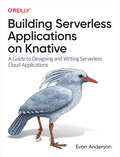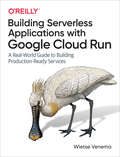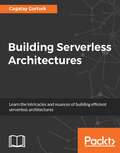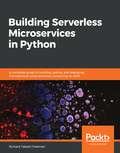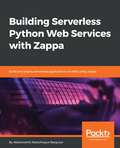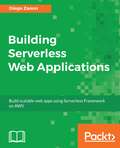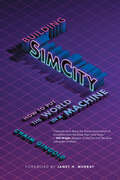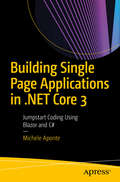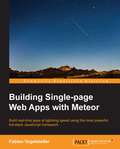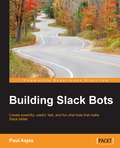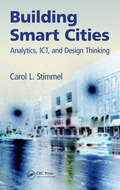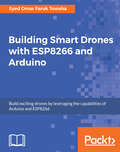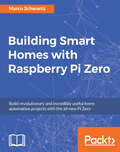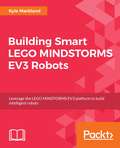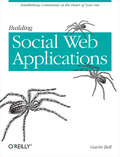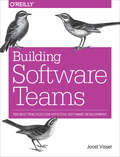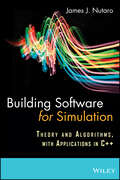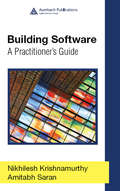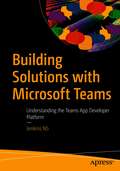- Table View
- List View
Building Secure PHP Applications: A Comprehensive Guide to Protecting Your Web Applications from Threats
by Satej Kumar SahuLearn how to protect PHP applications from potential vulnerabilities and attacks. As cyberattacks and data breaches continue to rise, it's crucial for developers and organizations to prioritize security in their PHP applications. The book offers an all-encompassing guide to securing PHP applications, covering topics ranging from PHP core security to web security, framework security (with a focus on Laravel), security standards, and protocol security. After examining PHP core security and essential topics, such as input validation, output encoding, secure session management, and secure file handling, you’ll move on to common security risks in PHP applications and provides practical examples to demonstrate effective security measures. From there, you’ll delve into web security, addressing XSS, SQL injection, and CSRF, reviewing in-depth explanations and mitigation techniques. A significant portion of the book focuses on Laravel's built-in security features, guiding readers to avoid common pitfalls. Industry-standard security protocols like HTTP, OAuth, and JSON Web Tokens are explained with demonstrations for how to effectively use them to ensure integrity, confidentiality, and authenticity in web applications. Additionally, protocol security is discussed, including secure communication, file transfer protocols (SFTP), and email handling. Security in cloud and hybrid environments is also discussed. This book's comprehensive and inclusive approach spans a wide range of security topics related to PHP and ensures that no critical areas are overlooked. It goes beyond theoretical concepts by providing practical guidance and actionable steps. It includes code snippets, real-world examples, case studies, and hands-on exercises, enabling you to apply the knowledge gained in practical scenarios. Building Secure PHP Applications provides a holistic approach to security, empowering you to build robust and resilient PHP applications. What You Will Learn Understand industry-recognized security standards and compliance requirements for data protection regulations. Learn the intricacies of Laravel and how to leverage its security features. Integrate security practices throughout the development lifecycle, conducting security testing and reviews and adopting secure deployment and DevOps practices. Conduct forensic analysis and perform post-incident analysis for continuous improvement. Look to the future and discover emerging security threats and techniques to anticipate and mitigate potential security risks. Who This Book Is For Primarily written for developers, security professionals, and webmasters involved in PHP application development. Additionally, this book may be used as a reference for students studying web development, PHP programming or cybersecurity
Building Secure Servers with Linux
by Michael D. BauerThis book provides a unique balance of "big picture" principles that transcend specific software packages and version numbers, and very clear procedures on securing some of those software packages. An all-inclusive resource for Linux users who wish to harden their systems, the book covers general security as well as key services such as DNS, the Apache Web server, mail, file transfer, and secure shell.
Building Secure and Reliable Systems: Best Practices for Designing, Implementing, and Maintaining Systems
by Betsy Beyer Heather Adkins Paul Blankinship Piotr Lewandowski Ana Oprea Adam StubblefieldCan a system be considered truly reliable if it isn't fundamentally secure? Or can it be considered secure if it's unreliable? Security is crucial to the design and operation of scalable systems in production, as it plays an important part in product quality, performance, and availability. In this book, experts from Google share best practices to help your organization design scalable and reliable systems that are fundamentally secure.Two previous O’Reilly books from Google—Site Reliability Engineering and The Site Reliability Workbook—demonstrated how and why a commitment to the entire service lifecycle enables organizations to successfully build, deploy, monitor, and maintain software systems. In this latest guide, the authors offer insights into system design, implementation, and maintenance from practitioners who specialize in security and reliability. They also discuss how building and adopting their recommended best practices requires a culture that’s supportive of such change.You’ll learn about secure and reliable systems through:Design strategiesRecommendations for coding, testing, and debugging practicesStrategies to prepare for, respond to, and recover from incidentsCultural best practices that help teams across your organization collaborate effectively
Building Serverless Applications on Knative: A Guide to Designing and Writing Serverless Cloud Applications
by Evan AndersonExplore the theory and practice of designing and writing serverless applications using examples from the Knative project. With this practical guide, mid-level to senior application developers and team managers will learn when and why to target serverless platforms when developing microservices or applications. Along the way, you'll also discover warning signs that suggest cases when serverless might cause you more trouble than joy.Drawing on author Evan Anderson's 15 years of experience developing and maintaining applications in the cloud, and more than 6 years of experience with serverless platforms at scale, this book acts as your guide into the high-velocity world of serverless application development. You'll come to appreciate why Knative is the most widely adopted open source serverless platform available. With this book, you will:Learn what serverless is, how it works, and why teams are adopting itUnderstand the benefits of Knative for cloud native development teamsLearn how to build a serverless application on KnativeExplore the challenges serverless introduces for debugging and the tools that can help improve itLearn why event-driven architecture and serverless compute are complementary but distinctUnderstand when a serverless approach might not be the right system design
Building Serverless Applications with Google Cloud Run
by Wietse VenemaLearn how to build a real-world serverless application in the cloud that's reliable, secure, maintainable, and scalable. If you have experience building web applications on traditional infrastructure, this hands-on guide shows you how to get started with Cloud Run, a container-based serverless product on Google Cloud.Through the course of this book, you'll learn how to deploy several example applications that highlight different parts of the serverless stack on Google Cloud. Combining practical examples with fundamentals, this book will appeal to developers who are early in their learning journey as well as experienced practitioners.Build a serverless application with Google Cloud RunLearn approaches for building containers with (and without) DockerExplore Google Cloud's managed relational database: Cloud SQLUse HTTP sessions to make every user's experience uniqueExplore identity and access management (IAM) on Cloud RunProvision Google Cloud resources using TerraformLearn how to handle background task scheduling on Cloud RunMove your service from Cloud Run to Knative Serving with little effort
Building Serverless Applications with Python: Develop fast, scalable, and cost-effective web applications that are always available
by Jalem Raj RohitBuilding efficient Python applications at minimal cost by adopting serverless architecturesKey Features Design and set up a data flow between cloud services and custom business logic Make your applications efficient and reliable using serverless architecture Build and deploy scalable serverless Python APIsBook DescriptionServerless architectures allow you to build and run applications and services without having to manage the infrastructure. Many companies have adopted this architecture to save cost and improve scalability. This book will help you design serverless architectures for your applications with AWS and Python.The book is divided into three modules. The first module explains the fundamentals of serverless architecture and how AWS lambda functions work. In the next module, you will learn to build, release, and deploy your application to production. You will also learn to log and test your application. In the third module, we will take you through advanced topics such as building a serverless API for your application. You will also learn to troubleshoot and monitor your app and master AWS lambda programming concepts with API references. Moving on, you will also learn how to scale up serverless applications and handle distributed serverless systems in production.By the end of the book, you will be equipped with the knowledge required to build scalable and cost-efficient Python applications with a serverless framework.What you will learn Understand how AWS Lambda and Microsoft Azure Functions work and use them to create an application Explore various triggers and how to select them, based on the problem statement Build deployment packages for Lambda functions Master the finer details about building Lambda functions and versioning Log and monitor serverless applications Learn about security in AWS and Lambda functions Scale up serverless applications to handle huge workloads and serverless distributed systems in production Understand SAM model deployment in AWS LambdaWho this book is forThis book is for Python developers who would like to learn about serverless architecture. Python programming knowledge is assumed.
Building Serverless Architectures
by Cagatay GurturkBuild scalable, reliable, and cost-effective applications with a serverless architecture About This Book • Design a real-world serverless application from scratch • Learn about AWS Lambda function and how to use Lambda functions to glue other AWS Services • Use the Java programming language and well-known design patterns. Although Java is used for the examples in this book, the concept is applicable across all languages • Learn to migrate your JAX-RS application to AWS Lambda and API Gateway Who This Book Is For This book is for developers and software architects who are interested in designing on the back end. Since the book uses Java to teach concepts, knowledge of Java is required. What You Will Learn • Learn to form microservices from bigger Softwares • Orchestrate and scale microservices • Design and set up the data flow between cloud services and custom business logic • Get to grips with cloud provider's APIs, limitations, and known issues • Migrate existing Java applications to a serverless architecture • Acquire deployment strategies • Build a highly available and scalable data persistence layer • Unravel cost optimization techniques In Detail Over the past years, all kind of companies from start-ups to giant enterprises started their move to public cloud providers in order to save their costs and reduce the operation effort needed to keep their shops open. Now it is even possible to craft a complex software system consisting of many independent micro-functions that will run only when they are needed without needing to maintain individual servers. The focus of this book is to design serverless architectures, and weigh the advantages and disadvantages of this approach, along with decision factors to consider. You will learn how to design a serverless application, get to know that key points of services that serverless applications are based on, and known issues and solutions. The book addresses key challenges such as how to slice out the core functionality of the software to be distributed in different cloud services and cloud functions. It covers basic and advanced usage of these services, testing and securing the serverless software, automating deployment, and more. By the end of the book, you will be equipped with knowledge of new tools and techniques to keep up with this evolution in the IT industry. Style and approach The book takes a pragmatic approach, showing you all the examples you need to build efficient serverless applications.
Building Serverless Microservices in Python: A complete guide to building, testing, and deploying microservices using serverless computing on AWS
by Richard Takashi FreemanA practical guide for developing end-to-end serverless microservices in Python for developers, DevOps, and architects. Key Features Create a secure, cost-effective, and scalable serverless data API Use identity management and authentication for a user-specific and secure web application Go beyond traditional web hosting to explore the full range of cloud hosting options Book Description Over the last few years, there has been a massive shift from monolithic architecture to microservices, thanks to their small and independent deployments that allow increased flexibility and agile delivery. Traditionally, virtual machines and containers were the principal mediums for deploying microservices, but they involved a lot of operational effort, configuration, and maintenance. More recently, serverless computing has gained popularity due to its built-in autoscaling abilities, reduced operational costs, and increased productivity. Building Serverless Microservices in Python begins by introducing you to serverless microservice structures. You will then learn how to create your first serverless data API and test your microservice. Moving on, you'll delve into data management and work with serverless patterns. Finally, the book introduces you to the importance of securing microservices. By the end of the book, you will have gained the skills you need to combine microservices with serverless computing, making their deployment much easier thanks to the cloud provider managing the servers and capacity planning. What you will learn Discover what microservices offer above and beyond other architectures Create a serverless application with AWS Gain secure access to data and resources Run tests on your configuration and code Create a highly available serverless microservice data API Build, deploy, and run your serverless configuration and code Who this book is for If you are a developer with basic knowledge of Python and want to learn how to build, test, deploy, and secure microservices, then this book is for you. No prior knowledge of building microservices is required.
Building Serverless Python Web Services with Zappa: Build and deploy serverless applications on AWS using Zappa
by Abdulwahid Abdulhaque BarguzarMaster serverless architectures in Python and their implementation, with Zappa on three different frameworks.Key Features Scalable serverless Python web services using Django, Flask, and Pyramid. Learn Asynchronous task execution on AWS Lambda and scheduling using Zappa. Implementing Zappa in a Docker container.Book DescriptionServerless applications are becoming very popular these days, not just because they save developers the trouble of managing the servers, but also because they provide several other benefits such as cutting heavy costs and improving the overall performance of the application.This book will help you build serverless applications in a quick and efficient way. We begin with an introduction to AWS and the API gateway, the environment for serverless development, and Zappa. We then look at building, testing, and deploying apps in AWS with three different frameworks--Flask, Django, and Pyramid. Setting up a custom domain along with SSL certificates and configuring them with Zappa is also covered. A few advanced Zappa settings are also covered along with securing Zappa with AWS VPC.By the end of the book you will have mastered using three frameworks to build robust and cost-efficient serverless apps in Python.What you will learnBuild, test, and deploy a simple web service using AWS CLIIntegrate Flask-based Python applications, via AWS CLI configurationDesign Rest APIs integrated with Zappa for Flask and DjangoCreate a project in the Pyramid framework and configure it with ZappaGenerate SSL Certificates using Amazon Certificate ManagerConfigure custom domains with AWS Route 53Create a Docker container similar to AWS LambdaWho this book is forPython Developers who are interested in learning how to develop fast and highly scalable serverless applications in Python, will find this book useful
Building Serverless Web Applications
by Diego ZanonBuild scalable, efficient, and highly available web apps using AWS About This Book • Get an in-depth understanding of the serverless model • Build a complete serverless web application end to end • Learn how to use the Serverless Framework to improve your productivity Who This Book Is For If you're looking to learn more about scalable and cost-efficient architectures, this book is for you. Basic knowledge of Node.js skills or familiarity with cloud services is required. For other topics, we cover the basics. What You Will Learn • Get a grasp of the pros and cons of going serverless and its use cases • Discover how you can use the building blocks of AWS to your advantage • Set up the environment and create a basic app with the Serverless Framework • Host static files on S3 and CloudFront with HTTPS support • Build a sample application with a frontend using React as an SPA • Develop the Node.js backend to handle requests and connect to a SimpleDB database • Secure your applications with authentication and authorization • Implement the publish-subscribe pattern to handle notifications in a serverless application • Create tests, define the workflow for deployment, and monitor your app In Detail This book will equip you with the knowledge needed to build your own serverless apps by showing you how to set up different services while making your application scalable, highly available, and efficient. We begin by giving you an idea of what it means to go serverless, exploring the pros and cons of the serverless model and its use cases. Next, you will be introduced to the AWS services that will be used throughout the book, how to estimate costs, and how to set up and use the Serverless Framework. From here, you will start to build an entire serverless project of an online store, beginning with a React SPA frontend hosted on AWS followed by a serverless backend with API Gateway and Lambda functions. You will also learn to access data from a SimpleDB database, secure the application with authentication and authorization, and implement serverless notifications for browsers using AWS IoT. This book will describe how to monitor the performance, efficiency, and errors of your apps and conclude by teaching you how to test and deploy your applications. Style and approach This book takes a step-by-step approach on how to use the Serverless Framework and AWS services to build Serverless Applications. It will give you a hands-on feeling, allowing you to practice while reading. It provides a brief introduction of concepts while keeping the focus on the practical skills required to develop applications.
Building SimCity: How to Put the World in a Machine (Game Histories)
by Chaim GingoldA deep dive into the trailblazing simulation game SimCity, situating it in the history of games, simulation, and computing.Building SimCity explores the history of computer simulation by chronicling one of the most influential simulation games ever made: SimCity. As author Chaim Gingold explains, Will Wright, the visionary designer behind the urban planning game, created SimCity in part to learn about cities, appropriating ideas from traditions in which computers are used as tools for modeling and thinking about the world as a complex system. As such, SimCity is a microcosm of the histories and cultures of computer simulation that engages with questions, themes, and representational techniques that reach back to the earliest computer simulations.Gingold uses SimCity to explore a web of interrelated topics in the history of technology, software, and simulation, taking us far and wide—from the dawn of programmable computers to miniature cities made of construction paper and role-play. An unprecedented history of Maxis, the company founded to bring SimCity to market, the book reveals Maxis&’s complex relations with venture capitalists, Nintendo, and the Santa Fe Institute, which shaped the evolution of Will Wright&’s career; Maxis&’s failure to back The Sims to completion; and the company&’s sale to Electronic Arts.A lavishly visual book, Building SimCity boasts a treasure trove of visual matter to help bring its wide-ranging subjects to life, including painstakingly crafted diagrams that explain SimCity&’s operation, the Kodachrome photographs taken by Charles Eames of schoolchildren making model cities, and Nintendo&’s manga-style &“Dr. Wright&” character design, just to name a few.
Building Single Page Applications in .NET Core 3: Jumpstart Coding Using Blazor and C#
by Michele AponteAttention .NET developers who no longer want to use JavaScript for your front end. Quickly and efficiently learn how to use C# for your single-page application (SPA) thanks to Blazor. Today’s reality is that most modern applications are web-based and if you want the same user experience as a desktop application, you need to be able to create a single-page application. While there are multiple frameworks and libraries to choose from (including Angular, React, and VueJS), you still need to know how to code in JavaScript. But now there is another option from Microsoft. Blazor is an open-source framework that enables developers to create web applications using C# and HTML, and everything you need to get started is covered in this guide. You will learn the steps, through build-along coding examples, that will allow you to use the same language for both the front end and the back end of your application. This book is designed to get you comfortable creating a single-page application in the shortest time possible. Get ready to create a complete business application that teaches and reinforces the skills you need in a Blazor production environment.What You Will Learn Develop the front end of an application using C# and .NET Core Use this quick-start for .NET developers who need to improve their application with a single-page front end Take a code-first approach that models an actual business application Gain insights for developing a high-functioning and maintainable applicationStudy guidance on repurposing your .NET skill setWho This Book Is ForC# and .NET developers who have some experience in web development
Building Single-page Web Apps with Meteor
by Fabian VogelstellerIf you are a web developer with basic knowledge of JavaScript and want to take on Web 2.0, build real-time applications, or simply want to write a complete application using only JavaScript and HTML/CSS, this is the book for you. This book is based on Meteor 1.0.
Building Slack Bots
by Paul AsjesThis is a book for software developers who want to build Slack bots for their own company's use or for customers. You need to know JavaScript.
Building Smart Cities: Analytics, ICT, and Design Thinking
by Carol L. StimmelThe term "smart city" defines the new urban environment, one that is designed for performance through information and communication technologies. Given that the majority of people across the world will live in urban environments within the next few decades, it's not surprising that massive effort and investment is being placed into efforts to devel
Building Smart Drones with ESP8266 and Arduino: Build exciting drones by leveraging the capabilities of Arduino and ESP8266
by Syed Omar TowahaLeverage the WiFi chip to build exciting QuadcoptersKey FeaturesLearn to create a fully functional Drone with Arduino and ESP8266 and their modified versions of hardware.Enhance your drone's functionalities by implementing smart features.A project-based guide that will get you developing next-level drones to help you monitor a particular area with mobile-like devices.Book DescriptionWith the use of drones, DIY projects have taken off. Programmers are rapidly moving from traditional application programming to developing exciting multi-utility projects. This book will teach you to build industry-level drones with Arduino and ESP8266 and their modified versions of hardware. With this book, you will explore techniques for leveraging the tiny WiFi chip to enhance your drone and control it over a mobile phone. This book will start with teaching you how to solve problems while building your own WiFi controlled Arduino based drone. You will also learn how to build a Quadcopter and a mission critical drone. Moving on you will learn how to build a prototype drone that will be given a mission to complete which it will do it itself. You will also learn to build various exciting projects such as gliding and racing drones. By the end of this book you will learn how to maintain and troubleshoot your drone. By the end of this book, you will have learned to build drones using ESP8266 and Arduino and leverage their functionalities to the fullest.What you will learnIncludes a number of projects that utilize different ESP8266 and Arduino capabilities, while interfacing with external hardwareCovers electrical engineering and programming concepts, interfacing with the World through analog and digital sensors, communicating with a computer and other devices, and internet connectivityControl and fly your quadcopter, taking into account weather conditionsBuild a drone that can follow the user wherever he/she goesBuild a mission-control drone and learn how to use it effectivelyMaintain your vehicle as much as possible and repair it whenever requiredWho this book is forIf you are a programmer or a DIY enthusiast and keen to create a fully functional drone with Arduino and ESP8266, then this book is for you. Basic skills in electronics and programming would be beneficial. This book is not for the beginners as it includes lots of ideas not detailed how you can do that. If you are a beginner, then you might get lost here. The prerequisites of the book include a good knowledge of Arduino, electronics, programming in C or C++ and lots of interest in creating things out of nothing.
Building Smart Homes with Raspberry Pi Zero
by Marco SchwartzBuild revolutionary and incredibly useful home automation projects with the all-new Pi Zero About This Book • Create and program home automation projects using the Raspberry Pi Zero board • Connect your Raspberry Pi Zero to a cloud API, and then build a cloud dashboard to control your devices • Integrate all the projects into a complex project to automate key aspects of your home: data monitoring, devices control, and security Who This Book Is For This book is for enthusiasts and programmers who want to build powerful and inexpensive home automation projects using the Raspberry Pi zero, and to transform their home into a smart home. It is for those who are new to the field of home automation, or who already have experience with other platforms such as Arduino. What You Will Learn • Learn how to measure and store data using the Raspberry Pi Zero board • Control LED lights, lamps, and other electrical applications • Send automated notifications by e-mail, SMS, or push notifications • Connect motion detectors, cameras, and alarms • Create automated alerts using Raspberry Pi Zero boards • Control devices using cloud-based services • Build a complete home automation system using Pi Zero In Detail The release of the Raspberry Pi Zero has completely amazed the tech community. With the price, form factor, and being high on utility—the Raspberry Pi Zero is the perfect companion to support home automation projects and makes IoT even more accessible. With this book, you will be able to create and program home automation projects using the Raspberry Pi Zero board. The book will teach you how to build a thermostat that will automatically regulate the temperature in your home. Another important topic in home automation is controlling electrical appliances, and you will learn how to control LED Lights, lamps, and other electrical applications. Moving on, we will build a smart energy meter that can measure the power of the appliance, and you'll learn how to switch it on and off. You'll also see how to build simple security system, composed of alarms, a security camera, and motion detectors. At the end, you will integrate everything what you learned so far into a more complex project to automate the key aspects of your home. By the end, you will have deepened your knowledge of the Raspberry Pi Zero, and will know how to build autonomous home automation projects. Style and approach This book takes a step-by-step approach to automate your home like never before!
Building Smart LEGO MINDSTORMS EV3 Robots: Leverage the LEGO MINDSTORMS EV3 platform to build and program intelligent robots
by Kyle MarklandBuild and program smart robots with the EV3.Key FeaturesEfficiently build smart robots with the LEGO MINDSTORMS EV3Discover building techniques and programming concepts that are used by engineers to prototype robots in the real world This project-based guide will teach you how to build exciting projects such as the objecta-tracking tank, ultimate all-terrain vehicle, remote control race car, or even a GPS-navigating autonomous vehicle Book DescriptionSmart robots are an ever-increasing part of our daily lives. With LEGO MINDSTORMS EV3, you can now prototype your very own small-scale smart robot that uses specialized programming and hardware to complete a mission. EV3 is a robotics platform for enthusiasts of all ages and experience levels that makes prototyping robots accessible to all.This book will walk you through six different projects that range from intermediate to advanced level. The projects will show you building and programming techniques that are used by engineers in the real world, which will help you build your own smart robot.You'll see how to make the most of the EV3 robotics platform and build some awesome smart robots. The book starts by introducing some real-world examples of smart robots. Then, we'll walk you through six different projects and explain the features that allow these robots to make intelligent decisions. The book will guide you as you build your own object-tracking tank, a box-climbing robot, an interactive robotic shark, a quirky bipedal robot, a speedy remote control race car, and a GPS-navigating robot.By the end of this book, you'll have the skills necessary to build and program your own smart robots with EV3.What you will learn Understand the characteristics that make a robot smart Grasp proportional beacon following and use proximity sensors to track an objectDiscover how mechanisms such as rack-and-pinion and the worm gear work Program a custom GUI to make a robot more user friendly Make a fun and quirky interactive robot that has its own personality Get to know the principles of remote control and programming car-style steering Understand some of the mechanisms that enable a car to drive Navigate to a destination with a GPS receiverWho this book is forThis book is for hobbyists, robotic engineers, and programmers who understand the basics of the EV3 programming language and are familiar with building with LEGO Technic and want to try some advanced projects. If you want to learn some new engineering techniques and take your experience with the EV3 to the next level, then this book is for you.
Building Social Equity with AI: Validating User Transactions with AI
by Raghu BandaDid you ever think that the way you interact with other human beings, entities, and organizations can be measured for building a harmonious society? In this age of user verification and user validation, AI will fine-tune these interactions and transactions to build a socially equitable world. This book reveals that social equity is not only what you get from society, but also what you give to it. You’ll explore the concepts and intricacies of this mutually built phenomenon. The book then and focuses on creating social equity awareness and details how AI can help in the process. Regular enterprises, consumer-oriented companies, and social media companies all capture data in regular interactions and use this information in various ways. You’ll learn how this information is being leveraged and explore how social equity can thrive when all this information is analyzed and measured.Building Social Equity with AI highlights the subtle nuances of social equity and howAI can create more awareness towards it, thus improving your business or organization.What You’ll LearnUnderstand how social equity affects all business and industry professionalsBuild social equity into a changing worldSee how AI and GenAI stand out as transformative forcesIntegrate social equity into network structuresAddress equality and equity in the context of people, processes, and technologyWork with AI to improve social equity scores Who This Book Is ForSmall-medium business owners and users, consultants, education specialists, career coaches, data engineers, and social workers who want to leverage AI to gain social equity for either their business or personal life.
Building Social Web Applications: Establishing Community at the Heart of Your Site
by Gavin BellBuilding a web application that attracts and retains regular visitors is tricky enough, but creating a social application that encourages visitors to interact with one another requires careful planning. This book provides practical solutions to the tough questions you'll face when building an effective community site -- one that makes visitors feel like they've found a new home on the Web.If your company is ready to take part in the social web, this book will help you get started. Whether you're creating a new site from scratch or reworking an existing site, Building Social Web Applications helps you choose the tools appropriate for your audience so you can build an infrastructure that will promote interaction and help the community coalesce. You'll also learn about business models for various social web applications, with examples of member-driven, customer-service-driven, and contributor-driven sites. Determine who will be drawn to your site, why they'll stay, and who they'll interact withCreate visual design that clearly communicates how your site worksBuild the software you need versus plugging in one-size-fits-all, off-the-shelf appsManage the identities of your visitors and determine how to support their interactionMonitor demand from the community to guide your choice of new functionsPlan the launch of your site and get the message out
Building Software Teams: Ten Best Practices for Effective Software Development
by Gijs Wijnholds Joost Visser Sylvan Rigal Zeeger LubsenWhy does poor software quality continue to plague enterprises of all sizes in all industries? Part of the problem lies with the process, rather than individual developers. This practical guide provides ten best practices to help team leaders create an effective working environment through key adjustments to their process.As a follow-up to their popular book, Building Maintainable Software, consultants with the Software Improvement Group (SIG) offer critical lessons based on their assessment of development processes used by hundreds of software teams. Each practice includes examples of goalsetting to help you choose the right metrics for your team.Achieve development goals by determining meaningful metrics with the Goal-Question-Metric approachTranslate those goals to a verifiable Definition of DoneManage code versions for consistent and predictable modificationControl separate environments for each stage in the development pipelineAutomate tests as much as possible and steer their guidelines and expectationsLet the Continuous Integration server do much of the hard work for youAutomate the process of pushing code through the pipelineDefine development process standards to improve consistency and simplicityManage dependencies on third party code to keep your software consistent and up to dateDocument only the most necessary and current knowledge
Building Software for Simulation
by James J. NutaroA unique guide to the design and implementation of simulation softwareThis book offers a concise introduction to the art of building simulation software, collecting the most important concepts and algorithms in one place. Written for both individuals new to the field of modeling and simulation as well as experienced practitioners, this guide explains the design and implementation of simulation software used in the engineering of large systems while presenting the relevant mathematical elements, concept discussions, and code development.The book approaches the topic from the perspective of Zeigler's theory of modeling and simulation, introducing the theory's fundamental concepts and showing how to apply them to engineering problems. Readers will learn five necessary skills for building simulations of complicated systems:Working with fundamental abstractions for simulating dynamic systemsDeveloping basic simulation algorithms for continuous and discrete event modelsCombining continuous and discrete event simulations into a coherent wholeApplying strategies for testing a simulationUnderstanding the theoretical foundations of the modeling constructs and simulation algorithmsThe central chapters of the book introduce, explain, and demonstrate the elements of the theory that are most important for building simulation tools. They are bracketed by applications to robotics, control and communications, and electric power systems; these comprehensive examples clearly illustrate how the concepts and algorithms are put to use. Readers will explore the design of object-oriented simulation programs, simulation using multi-core processors, and the integration of simulators into larger software systems.The focus on software makes this book particularly useful for computer science and computer engineering courses in simulation that focus on building simulators. It is indispensable reading for undergraduate and graduate students studying modeling and simulation, as well as for practicing scientists and engineers involved in the development of simulation tools.
Building Software: A Practitioner's Guide
by Nikhilesh Krishnamurthy Amitabh SaranProviding a framework to guide software professionals through the many aspects of development, Building Software: A Practitioner's Guide shows how to master systems development and manage many of the soft and technical skills that are crucial to the successful delivery of systems and software. It encourages tapping into a wealth of cross-domain and legacy solutions to overcome common problems, such as confusion about requirements and issues of quality, schedule, communication, and people management. The book offers insight into the inner workings of software reliability along with sound advice on ensuring that it meets customer and organizational needs.
Building Solutions with Microsoft Teams: Understanding the Teams App Developer Platform
by Jenkins NSExplore Microsoft Teams and use its principal tools such as Node.js, npm, Yeoman, Gulp, TypeScript, and React to help you develop for Teams better. This book covers the core components and use cases for Teams apps and guides you through ideas for automation, provisioning, and implementation. Building Solutions with Microsoft Teams starts with an overview of the Microsoft Teams developer platform followed by how to set up your environment for building apps and solutions with Teams. You will then go through various features of conversational bots and learn how to create a bot. You will gain an understanding of the messaging extension and command actions along with tabs for personal, groups, and teams contexts. Moving forward, you will work with SharePoint and Teams together via SharePoint Framework. Finally, you will manage the Teams life cycle and see design guidelines supported by various case studies. After reading this book, you will be able to integrate solutions from Power Apps, Power Automate, Power BI, and Power Virtual agents by using accelerators. You will also be able to leverage your existing skills from SharePoint Framework development. What You Will Learn Extend the Teams developer platform capabilitiesUnderstand Microsoft Graph, including lifecycle management, collaboration, calling, and online meetingsCreate an app package for your Microsoft Teams appConnect web services to Microsoft Teams with webhooks Who This Book Is ForMicrosoft Teams developers.
Building Solutions with Microsoft® Commerce Server 2002
by Clayton C. Peddy Derek ArmentroutNo matter what your organization sells, a well-executed commerce solution can extend your business globally, boost profitability, and help you seize new opportunities faster. Drawing from their extensive, in-the-field experience, online business experts Clayton Peddy and Derek Armentrout teach you to quickly build and deploy a scalable, high-performance site using Commerce Server 2002. They detail how to customize your own solution--incorporating components such as a product catalog, a shopping cart, user profiles, content management, and data-warehousing and analysis capabilities. You get focused, field-proven techniques and hands-on instruction--along with reusable Code Candy from real-world solutions. Discover how to: Determine the business and technical requirements for your site Create and manage user profiles and implement authentication Use Microsoft Content Management Server to manage page templates, images, product data, and other resources Design product catalogs that are easy to use and manage Build the browse, registration, and shopping cart pages Exploit little-known pipeline capabilities, such as inventory calculation and third-party order processing Capture and analyze data on user demographics and buying patterns Create campaigns, promotions, and awards for targeted users Manage site operations using the Business Desk modules Test, stage, and launch your solution



